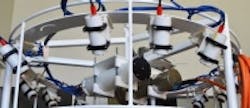A vision system designed by a team of researchers in Canada utilizes eight cameras and three projectors arranged in a circular rig in order to acquire 3D information from underwater habitats.
MORE ARTICLES
Cornell vision-enabled underwater vehicle seeks fourth straight RoboSub Competition win
Autonomous underwater robot targets search and tracking operations
The prototype rig— which was developed by scientists at the University of Alberta—is the second of its kind. The first was installed on the NEPTUNE Observatory’s Folger Passage site off the shore of British Columbia (BC) in order to observe the colonization of artificial reef balls while improving the 3D camera calibration and imaging techniques for future iterations.
The new 3D vision system, which will also observe underwater habitats and reef ball structure, features multiple components, beginning with eight Flea3 GigE cameras (FL3-GE-50S5C-C) from Point Grey. These cameras feature a 5 MPixel Sony ICX655 global shutter CCD image sensor with a 3.45 µm pixel size, 8 fps frame rate, and 12-bit ADC. The cameras are controlled via Ethernet cable for streaming data. The projectors used in the rig are DLP Lightcrafter projectors from Texas Instruments. These compact modules project light via an RGB LED light engine.
One significant difference between the new model and the previous one is that the system offers improved 3D capabilities, Xida Chen, a PhD student with the Department of Computing Science, University of Alberta, who designed and supervised calibration of the cameras, told Gizmodo.
"With our camera-projector configuration, our system can reconstruct the 3D model of the habitat with the error in millimeter level," Chen said. "Some of the existing underwater camera system provides images of the habitat where the information is 2D only. For others that provide 3D information, it is not as accurate."
The challenge of the new system is camera calibration, where the team needs to obtain accurate parameters to accommodate for the water and glass refraction, so that the error in the 3D model can be minimized, added Chen.
This new model will be deployed as a proof of concept for the next six months in the Saanich Inlet, which is just northwest of Victoria, BC. If the rig meets the team’s expectations, additional cameras and/or projectors will be added in order to round it out and to produce a full 360° composite image.
View the Gizmodo article.
Share your vision-related news by contacting James Carroll, Senior Web Editor, Vision Systems Design
To receive news like this in your inbox, click here.
Join our LinkedIn group | Like us on Facebook | Follow us on Twitter | Check us out on Google +
About the Author

James Carroll
Former VSD Editor James Carroll joined the team 2013. Carroll covered machine vision and imaging from numerous angles, including application stories, industry news, market updates, and new products. In addition to writing and editing articles, Carroll managed the Innovators Awards program and webcasts.
